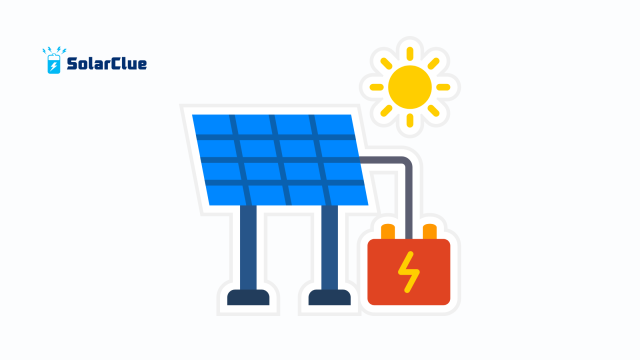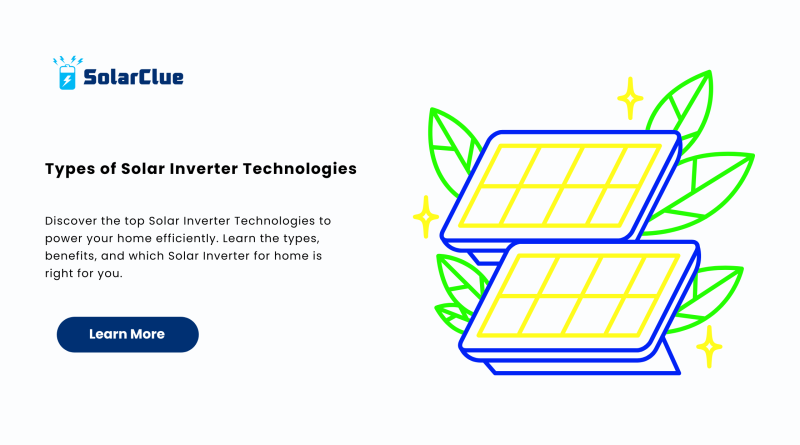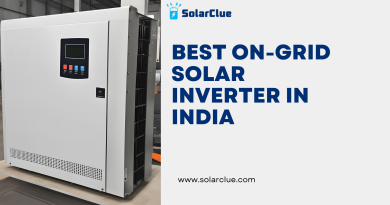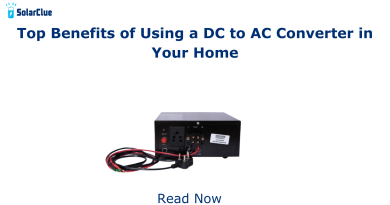Types of Solar Inverter Technologies
A Solar Inverter is the brain of your solar power system. It converts the DC electricity generated by solar panels into AC electricity, which powers your appliances. Choosing the right inverter is critical for optimal energy efficiency. As solar energy continues to surge in popularity across India and the globe, understanding how different Solar Inverter Technologies function can help homeowners and businesses alike make smarter, more cost-effective decisions. Whether you’re looking to invest in a Solar Inverter for home, upgrade your current setup, or simply explore the latest innovations in solar, this guide covers everything you need to know.
Table of Contents
- 1 1. String Inverters
- 2 2. Microinverters
- 3 3. Power Optimizers
- 4 4. Hybrid Inverters
- 5 5. Off-Grid Inverters
- 6 6. Grid-Tied Inverters
- 7 Key Features to Consider in Solar Inverters
- 8 Comparing Inverter Types
- 9 Installation Tips
- 10 Maintenance and Monitoring
- 11 Cost Breakdown
- 12 Which Inverter is Right for You?
- 13 Government Incentives
- 14 Future of Solar Inverters
- 15 Environmental Impact
- 16 Final Thoughts
- 17 FAQs
1. String Inverters
What Are String Inverters?
String inverters are the most commonly used Solar Inverter Technologies in residential and commercial setups. Multiple panels are connected in series, forming a ‘string’ that is routed into one central inverter.
Pros of String Inverters
- Cost-effective
- Easy to maintain
- Reliable for uniform panel conditions
Cons of String Inverters
- Performance drops if one panel underperforms
- Limited monitoring of individual panels
2. Microinverters
How Do Microinverters Work?
Unlike string inverters, microinverters are installed on each solar panel. They individually convert DC to AC, improving overall system performance.
Benefits of Microinverters
- Maximizes power output
- Excellent for shaded areas
- Enhanced panel-level monitoring
Drawbacks
- Higher upfront cost
- Slightly complex installation
3. Power Optimizers

Hybrid Between String Inverters and Microinverters
Power optimizers are attached to each panel but work with a centralized inverter. They condition the power before sending it to the inverter.
Advantages
- Improved efficiency
- Flexibility in panel layout
- Lower cost than microinverters
Limitations
- Dependent on central inverter
- More components to install
4. Hybrid Inverters
Dual-Functionality for Grid and Battery Use
Hybrid inverters can manage both solar panels and battery storage, making them ideal for modern energy systems.
Why Choose Hybrid?
- Energy storage integration
- Backup during grid failures
- Smart energy management
5. Off-Grid Inverters
Independent Power Source
Off-grid inverters are used where there’s no utility connection. These are often paired with batteries and charge controllers.
Best Use Cases
- Remote areas
- Farms
- Emergency backup systems
6. Grid-Tied Inverters
Seamless Utility Integration
Grid-tied inverters sync with your local utility grid and are ideal for urban installations where net metering is available.
Benefits
- Cost savings through net metering
- No need for battery storage
- Simpler design
Key Features to Consider in Solar Inverters
What Makes the Best Solar Inverter?
When evaluating Solar Inverter Technologies, consider the following features:
- Efficiency rating
- Durability and warranty
- Monitoring capabilities
- Compatibility with battery systems
- Service and support
Comparing Inverter Types
| Inverter Type | Cost | Efficiency | Best For |
|---|---|---|---|
| String Inverter | Low | Moderate | Uniform sun exposure |
| Microinverter | High | High | Shaded roofs |
| Power Optimizer | Moderate | High | Complex roofs |
| Hybrid Inverter | High | Very High | Battery storage systems |
| Off-Grid Inverter | High | Variable | Remote areas |
| Grid-Tied Inverter | Moderate | High | Urban homes |
Installation Tips
Expert Guidance
Professional installation is crucial for safety and performance. Poor installation can degrade inverter life and reduce power output.
Maintenance and Monitoring
Keeping Your System Healthy
Modern inverters offer app-based monitoring for real-time performance checks. Regular servicing ensures longevity and efficiency.
Cost Breakdown
Pricing Insights
The price of a Solar Inverter for home depends on type, brand, and capacity. Expect:
- String Inverters: ₹15,000 – ₹35,000
- Microinverters: ₹7,000 – ₹15,000 per panel
- Hybrid Inverters: ₹40,000 – ₹90,000
Which Inverter is Right for You?
Your choice depends on roof size, shading, budget, and energy goals. For basic needs, string inverters are excellent. For optimal output and future-proofing, hybrid or microinverters are ideal.
Government Incentives
Save While You Go Green
India’s Ministry of New and Renewable Energy (MNRE) offers subsidies for solar installations. Check your local policies for the latest schemes.
Future of Solar Inverters
Smart and AI-Integrated Systems
With advancements in IoT and AI, Solar Inverter Technologies are becoming smarter, offering predictive maintenance and advanced energy analytics.
Environmental Impact
Go Green, Save Earth
Choosing the best Solar Inverter helps reduce carbon footprint and dependence on fossil fuels, making your home more sustainable.
Final Thoughts
When choosing among various Solar Inverter Technologies, balance cost, efficiency, and features based on your individual needs. A well-informed choice today can save you money and energy for decades.
FAQs
Q1: Which is the most efficient type of solar inverter?
A: Microinverters and hybrid inverters are considered the most efficient due to panel-level optimization and dual energy source management.
Q2: What is the lifespan of a solar inverter?
A: Most solar inverters last between 10 to 15 years, with premium models lasting up to 20 years.
Q3: Can I upgrade my solar inverter later?
A: Yes, most systems allow inverter upgrades to support new technologies or higher capacity needs.
Q4: Are hybrid inverters worth the cost?
A: Absolutely, if you’re planning to add battery storage or want energy independence, hybrid inverters offer excellent value.
Q5: How do I choose the right inverter for my home?
A: Evaluate your energy usage, roof structure, shading, and budget. Consulting a solar expert can help make an informed choice.
Explore smarter solar choices and energy independence—Visit our websites solarclue.com and blog.solarclue.com to find the right solution tailored just for you!




